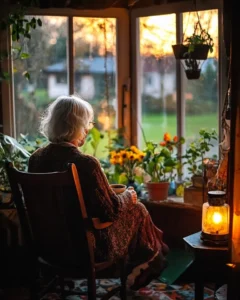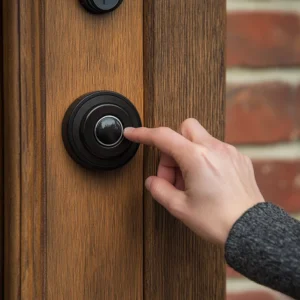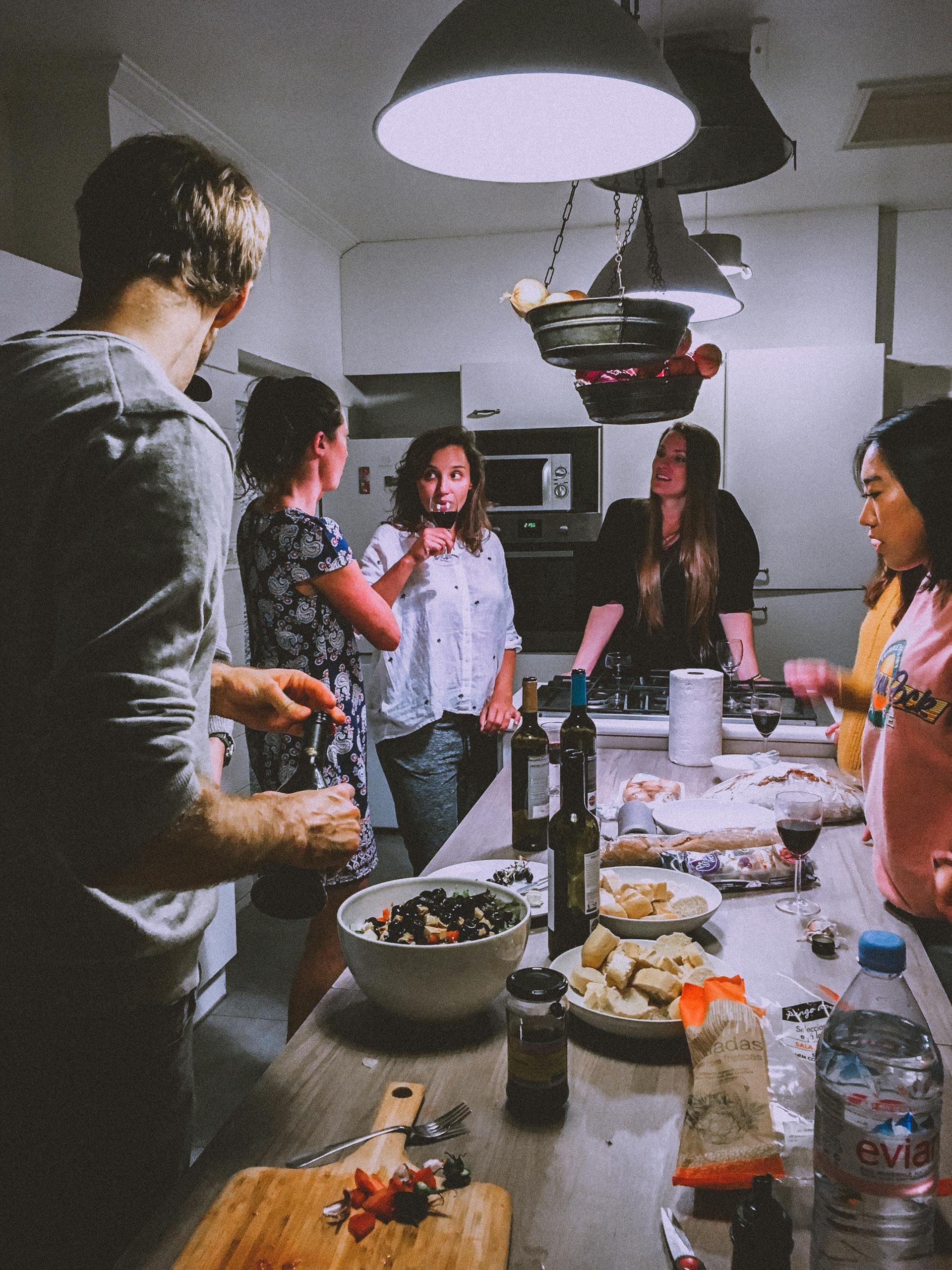Kevin had already made his Halloween costume with his mom and helped his dad decorate their house. He was excited about how much candy he would collect. But one house on his street didn’t have any decorations, and that kept bothering him. He didn’t understand why someone wouldn’t celebrate Halloween, so he thought maybe they needed help.
Halloween was almost here, and the entire neighborhood was buzzing with excitement. Every yard seemed to be trying to be the scariest one around.
There were pumpkins with big, jagged smiles all along the sidewalks. Plastic skeletons hung from tree branches, and fake cobwebs covered porches.
The air smelled like dry leaves and candy, and eleven-year-old Kevin could feel his heart racing with excitement.

Halloween was Kevin’s favorite day of the year, a time when anyone could be whatever they wanted. He loved how everything changed for that one magical night.

As he walked down the street, he smiled, looking at the glowing jack-o’-lanterns and spooky ghosts decorating the houses. Some homes even played creepy sounds like witches’ laughter and creaking doors.

But something different caught his eye as he went farther down the street. One house was dark and plain, with no decorations at all. It was Mrs. Kimbly’s house.

Mrs. Kimbly was an older woman who lived alone. Kevin had helped her before, mowing her lawn in summer and shoveling snow in winter, but she rarely said much. Her undecorated house seemed out of place in the festive neighborhood.

Kevin felt bad that her house had no Halloween spirit. He thought maybe she needed help with the decorations. Determined, he crossed the street and knocked on her door.

When Mrs. Kimbly answered, her face showed annoyance. “What do you want, Kevin?” she asked in a gruff voice.

“I noticed you don’t have any Halloween decorations. I could help you put some up, if you’d like,” Kevin offered.

Mrs. Kimbly frowned. “I don’t need decorations, and I don’t need help,” she said sharply before slamming the door.

Kevin was surprised. How could anyone hate Halloween so much? He didn’t want her house to be a target for pranks, like kids throwing toilet paper, so he came up with a plan.

At home, Kevin told his mom, Sarah, about Mrs. Kimbly’s undecorated house and how she had slammed the door in his face. His mom suggested leaving her alone, explaining that people might have reasons for not celebrating.

But Kevin didn’t think Mrs. Kimbly hated Halloween—she seemed lonely. So, he decided to help anyway.

He gathered all the Halloween decorations he could find, including his favorite pumpkin, and hurried back to Mrs. Kimbly’s house. He carefully hung lights and placed pumpkins on her porch. As he finished, the front door opened, and Mrs. Kimbly stormed out, furious.

“I told you not to decorate my house!” she yelled. She grabbed Kevin’s carved pumpkin and smashed it on the ground. Kevin was shocked and hurt, but he whispered, “I just wanted to help,” before running home.

That night, Kevin put on his vampire costume, but he couldn’t enjoy Halloween. He was worried about Mrs. Kimbly’s house being pranked. So, he returned to her house and sat on her porch, handing out candy from his own bag to trick-or-treaters, explaining that Mrs. Kimbly wasn’t home.

As he sat alone, the door creaked open. Mrs. Kimbly stepped out, her expression softer this time.
“What are you doing here, Kevin?” she asked quietly.
“I didn’t want anyone to mess with your house,” Kevin explained. “I thought I could help.”
Mrs. Kimbly sighed and sat beside him. She admitted that Halloween was hard for her because it reminded her of how alone she was. She had no family to share it with.
Kevin understood now. “You don’t have to be alone,” he said. “You can celebrate with the rest of us.”

Mrs. Kimbly smiled sadly and thanked Kevin for his kindness. She even apologized for smashing his pumpkin. Kevin promised to bring another one so they could carve it together.
For the first time in years, Mrs. Kimbly felt the warmth of Halloween again, thanks to the caring heart of one determined boy.
Voltei para minha cidade natal com meu filho, mas meus velhos amigos o olharam chocados — só mais tarde descobri o porquê

Quando meu ex e eu nos separamos, escolhi me tornar uma mãe solteira por meio de doação de esperma, então eu tinha certeza de que sabia de onde meu filho veio. Mas quando nos mudamos de volta para minha cidade natal, a maneira como meus velhos amigos o encaravam fez meu estômago embrulhar.
Meus papéis de divórcio nem estavam frios quando decidi que queria um bebê. Não um marido, nem um namorado. Apenas um pequeno ser humano para chamar de meu.
Depois que meu ex, Ethan, deixou claro que nunca iria querer filhos e pediu para se separar, o caminho à frente parecia óbvio. Eu ainda me tornaria mãe. Mesmo se estivesse sozinha.

Um casal à beira do divórcio | Fonte: Pexels
“Você está mesmo fazendo isso?”, minha amiga Olivia perguntou do seu lugar no meu sofá enquanto me observava rolar os perfis dos doadores. “Garota, você tem apenas 28 anos.”
“E ficando mais velho a cada minuto.” Cliquei em outro perfil. “Além disso, o doador certo pode aparecer a qualquer momento.”
“O doador certo”, ela bufou. “Como se escolher o pai do seu filho fosse como fazer compras online.”

Uma mulher em um sofá | Fonte: Pexels
“Melhor do que meu histórico de namoro”, suspirei, e fechei meu laptop, esfregando meus olhos cansados. “Pelo menos esses caras são pré-examinados para doenças genéticas e antecedentes criminais. Mais do que posso dizer do meu ex.”
“Ponto justo”, Olivia assentiu e me entregou uma lata de refrigerante. “Mas e o amor? Você não quer que seu filho tenha um pai?”
“Eles vão me pegar. Já chega.”
Tomei um gole da minha Coca-Cola enquanto me lembrava da cara do Ethan quando mencionei filhos. O jeito como ele recuou como se eu tivesse sugerido que nos mudássemos para Marte.

Uma mulher bebendo refrigerante | Fonte: Pexels
“Além disso, muitas crianças crescem felizes com pais solteiros.”
***
O site do banco de esperma se tornou meu ritual noturno. Um metro e oitenta e dois, cabelo castanho, diploma de medicina. Tratei essa busca como se estivesse construindo o homem dos meus sonhos, exceto que este só contribuiria com DNA.
Sem relacionamentos bagunçados, sem decepções, sem Ethans. Apenas o presente da vida, embrulhado em um copo de espécime estéril.

Uma mulher em seu laptop | Fonte: Pexels
Jude, meu melhor amigo desde sempre, me apoiou em tudo. Ele até me ajudou a fazer as malas quando decidi mudar de estado para um novo começo.
“Connecticut?” Ele fechou outra caixa com fita adesiva, sua testa franzida em preocupação. “Isso é praticamente o Canadá.”
“É onde minha mãe cresceu. Ela amava lá. Pode ser legal. Eu não teria família por perto, mas realmente preciso de um novo começo.” Eu etiquetei a caixa como “Cozinha – Frágil” com traços fortes de Sharpie.

Uma mulher escrevendo em uma caixa de mudança | Fonte: Pexels
“É, mas…” ele começou enquanto brincava com a fita de embalagem. “E se você precisar de ajuda? Com o bebê?”
“É para isso que servem as babás”, eu disse e bati no ombro dele com o meu. “Pare de se preocupar tanto.”
Jude foi uma das melhores partes da minha vida, e minha festa de despedida foi ideia dele. Ele era pé no chão e confiável, diferente de Olivia, que ainda tinha um lado selvagem. Mas eu a amava também.

Pessoas reunidas em uma cozinha | Fonte: Pexels
Mas olhando para trás, eu deveria ter pensado melhor antes de deixá-la misturar as bebidas. Felizmente, enquanto a noite passava de risos para lágrimas, Jude ficou por perto.
Ele garantiu que eu não caísse de cara no meu bolo de despedida.
“Não acredito que você está realmente indo embora”, Olivia falou arrastado, me abraçando pela décima vez. “Quem vai ser meu companheiro de quarta-feira da Netflix?”
“O FaceTime existe por um motivo”, eu disse, me firmando contra o balcão da cozinha de Jude. A sala começou a girar em algum momento.

Uma sala de festa desfocada | Fonte: Pexels
“Prometa que não vai se esquecer de nós, pessoas pequenas, quando estiver vivendo sua vida chique no interior”, Jude disse mais tarde, me acompanhando até a porta. De repente, percebi que seu braço em volta da minha cintura parecia quente e seguro.
Então, o que aconteceu depois ainda me visita em sonhos.
***
Na semana seguinte, realizei o procedimento de inseminação e deixei Atlanta para trás.

Um médico | Fonte: Pexels
Nove meses depois, Alan veio gritando ao mundo, todo vermelho e perfeito. Seu primeiro choro perfurou algo profundo dentro de mim e desbloqueou um amor que eu nunca soube que existia.
Oito anos se passaram, e mesmo sendo cansativo, eu sabia que nasci para ser mãe. Meu filho cresceu e se tornou um garoto inteligente e engraçado, que fazia muitas perguntas e ria das próprias piadas.
A vida era boa, simples. Nossa pequena família de dois se sentia completa. Então minha mãe ficou doente, e eu tive que voltar.

Uma mãe segurando seu filho | Fonte: Pexels
“Estamos nos mudando para Atlanta por um tempo”, eu disse a Alan enquanto comíamos pizza. Seu rosto estava sujo de molho, como sempre. “Lembra onde a mamãe cresceu?”
Ele levou isso melhor do que o esperado, animado com a aventura. “Será que vou conhecer seus velhos amigos?”
“Claro que sim, amigo”, eu disse e limpei seu rosto com um guardanapo. “E a vovó precisa da nossa ajuda por um tempo.”
“Legal. Posso terminar sua crosta?”

Um menino comendo pizza | Fonte: Pexels
***
Eu não tinha planejado ficar muito tempo, apenas o suficiente para ajudar a mamãe em sua recuperação. Mas, caminhando por aquelas ruas familiares, algo mudou.
Alan precisava de raízes e família. Mais do que apenas eu. Além disso, eu não tinha percebido que tinha ido embora por causa de tudo o que aconteceu com Ethan.
Mas agora que eu estava de volta, me dei conta: eu tinha fugido das memórias do meu relacionamento fracassado, então talvez fosse hora de voltar para minha verdadeira casa.

Vista de uma cidade | Fonte: Pexels
Exceto… algo estranho começou a acontecer. Sussurros. Eles começaram no mercado. A Sra. Henderson, que ainda estava no mesmo caixa depois de todos esses anos, deixou cair seu scanner quando viu Alan.
“Oh meu Deus”, ela sussurrou enquanto sua mão voava para sua boca. “Este é seu…”
“Meu filho, Alan.” Eu o empurrei para frente. “Diga oi, querido.”
“Oi”, Alan murmurou, subitamente tímido. “Sua loja tem bons picolés.”

Um menino feliz | Fonte: Pexels
Ela continuou olhando para ele como se tivesse crescido uma segunda cabeça nele, e ela não era a única.
Ao longo da semana, reações semelhantes se seguiram. Antigos colegas de classe nos viam, olhavam duas vezes e então saíam correndo sussurrando.
Michael, meu antigo colega de laboratório, tropeçou nos próprios pés quando passamos por ele no parque.
“Seus amigos são estranhos, mãe”, Alan disse depois de outro encontro estranho. “Eles olham para mim de forma estranha.”

Um menino ao ar livre | Fonte: Pexels
“Eles são gente de cidade pequena, querida. Eles só não estão acostumados com rostos novos.”
“Tenho alguma coisa no rosto?”, ele perguntou e esfregou a bochecha, constrangido.
“Não, querida. Você é perfeita do jeito que é.”
Mas algo não estava certo. Os olhares e as expressões chocadas estavam me irritando. No entanto, esqueci disso, pois minha mãe precisava de mais e mais atenção.

Mulher idosa com cânula nasal | Fonte: Pexels
Então veio o festival de verão. Levei Alan, e nós dois aproveitamos o cheiro de algodão-doce e milho grelhado. Eu me senti mal porque tínhamos nos mudado para Atlanta bem no começo do verão e Alan não teve a chance de fazer amigos, o que era mais fácil na escola.
“Amelia?” Uma voz familiar me parou. “É você mesmo?”
Jude estava ali. Ele parecia mais velho, mas ainda tinha o mesmo sorriso torto. No entanto, uma mulher linda e chique segurou seu braço, e eu imediatamente vi sua aliança de casamento enquanto ela capturava e refletia a luz do sol.

Uma mulher loira ao ar livre | Fonte: Pexels
De qualquer forma, concentrei-me novamente no meu amigo. O tempo tinha sido gentil com ele. Ele tinha apenas alguns fios grisalhos nas têmporas e linhas de riso ao redor dos olhos, mas ele ainda era inegavelmente Jude.
“Jude, oi!”, eu disse, tentando agir casualmente, mas meu coração estava martelando. “Deve ser Eleanor. Ouvi falar muito de você de amigos em comum.”
Fizemos as gentilezas típicas, mas os olhos curiosos do meu amigo logo se voltaram para Alan, que estava ocupado devorando um cachorro-quente.
“Este é Alan”, eu disse, me sentindo mais relaxada. “Meu filho.”

Menino sorrindo | Fonte: Pexels
Eleanor sorriu calorosamente, mas franziu a testa, e Jude parecia ter visto um fantasma.
Foi então que me dei conta: os cachos castanhos rebeldes de Alan, o jeito como seu nariz enrugava quando ele ria, até mesmo como ele ficava com um quadril erguido… ele era a cara de Jude naquela idade.
Por que eu não tinha visto isso antes?
“Como…” A voz de Jude falhou. “Quantos anos ele tem?”

Um homem ao ar livre | Fonte: Pexels
“Oito”, eu suspirei, ainda cambaleando com a realização. Ele sabia esse número, é claro, porque eu fiz o procedimento aqui, logo antes de sair.
Mas isso foi depois da minha festa de despedida e das bebidas pesadas da Olivia.
“Mãe, você pode me dar outro corn dog?” Alan puxou minha manga, alheio à bomba que tinha acabado de detonar em nosso pequeno círculo. “Por favor? Prometo que vou comer meus vegetais no jantar.”

Um corndog | Fonte: Pexels
“Claro, querida.”
Eleanor pediu licença para pegar bebidas, mas apertou o braço de Jude antes de ir embora.
“Precisamos conversar”, disse Jude, ainda olhando para Alan como se estivesse tentando memorizar cada detalhe.
“É”, eu disse enquanto observava meu filho correr para a barraca de corn dog. Seu cabelo, com os cachos de Jude, balançava na brisa de verão. “Acho que sim.”

Barraca de comida em uma feira | Fonte: Pexels
“Ele…” Jude engoliu em seco. “Quero dizer, você contou a ele sobre o pai dele?”
“Ele acha que foi um doador”, respondi, balançando a cabeça. Foi o que pensei também . “Eu nunca imaginei… Quer dizer, o momento…”
“A festa”, Jude disse, passando a mão pelos cabelos. “Deus, Amelia. Por que você não me ligou?”
“Juro que não sabia. Realmente não sabia. Fiz o procedimento na semana seguinte, exatamente como planejei. Quando ele nasceu, eu simplesmente presumi… e então, eu estava tão envolvida em me estabelecer em um novo lugar, e como mãe… é por isso que todo mundo está olhando para ele de forma estranha.”

Uma mulher ao ar livre preocupada
A risada de Alan ecoou pelo festival e eu sorri.
Depois, Jude e eu concordamos quase imediatamente em uma coisa: fazer um teste, só para ter certeza. Nós descobriríamos o resto depois dos resultados.
Nós passamos por isso, e as respostas chegariam em duas semanas. Eu sabia que Jude gostaria de fazer parte da vida de Alan se os testes provassem a paternidade, e talvez isso fosse uma bênção.

Frascos para testes médicos | Fonte: Pexels
Porque Jude sempre foi o cara legal, o responsável, o amigo que nunca decepcionava ninguém. Claro, ele gostaria de ser pai do filho. Eu não sabia se a esposa dele ficaria feliz com isso.
Mas, de qualquer forma, minha vida perfeitamente planejada de mãe solteira parecia prestes a mudar novamente, e dessa vez eu não estava fugindo.
Às vezes, as melhores histórias são aquelas que nunca pretendemos escrever.

Mãe e filho | Fonte: Pexels
Quando Lori e Chris retornam de sua lua de mel dos sonhos, eles estão ansiosos para dar as boas-vindas à vida como um casal. Mas, ao entrarem em casa, eles encontram uma grande caixa preta no corredor. O que seria um presente de casamento se transforma na própria coisa que destrói seu relacionamento…
Este trabalho é inspirado em eventos e pessoas reais, mas foi ficcionalizado para fins criativos. Nomes, personagens e detalhes foram alterados para proteger a privacidade e melhorar a narrativa. Qualquer semelhança com pessoas reais, vivas ou mortas, ou eventos reais é mera coincidência e não intencional do autor.
O autor e a editora não fazem nenhuma reivindicação quanto à precisão dos eventos ou à representação dos personagens e não são responsáveis por nenhuma interpretação errônea. Esta história é fornecida “como está”, e quaisquer opiniões expressas são as dos personagens e não refletem as opiniões do autor ou da editora.



Leave a Reply